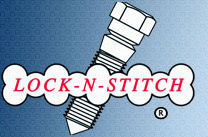Cast Iron Repair & Metal Stitching Frequently Asked Questions
- When should I use C Series pins and when can I use L Series Pins?
- Where are places that I can't use C Series Pins?
- Can I leave some of the C Series shoulder above the surface to add strength instead of grinding them smooth when working on thin material?
- Can C Series pins be installed in blind holes without the shoulder?
- What causes C Series pins to strip when tightened?
- How can I improve the finish I am getting on valve seats and other machined surfaces?
- Do I need locks when repairing long cracks in automotive engine blocks?
- What can I do to prevent tap breakage?
- How can I remove a broken tap?
QUESTION: When should I use C Series pins and when can I use L Series Pins?
C Series pins are used for structural repairs and/or when spreading pressure would cause the crack to extend. Cracks running along an inside or outside corner need to be repaired with C Series pins.
Because the L Series pins exert spreading pressure when tightened they are used when there is enough strength in the surrounding area to contain them. A good example of a perfect place for L Series pin installation is the valve seat area of cylinder heads.
QUESTION: Where are places that I can't use C Series Pins?
C Series pins cannot be installed at an angle greater than 20 degrees from perpendicular to the surface. Thin material is also a challenge for C Series because of the need to spotface the installation hole. Spotfacing reduces the thickness of the material that is left for thread installation. The minimum thickness of a casting for C1 pins is 0.125" and for C2F it is 0.200"
QUESTION: Can I leave some of the C Series shoulder above the surface to add strength instead of grinding them smooth when working on thin material?
Yes, this works very well. Leaving the shoulders protruding 0.020" to 0.050" above the surface can help. Peening them with a needle scaler makes it look like a raised weld bead and works best.
QUESTION: Can C Series pins be installed in blind holes without the shoulder?
Yes. In fact, that is the strongest installation for C Series pins. But when there is a though hole, you must use the spotfacer.
QUESTION: What causes C Series pins to strip when tightened?
This is caused by not having enough threads engaging the casting. Either your spotface is too deep or the material is just too thin. When faced with thin material, do not use the Pin Spacing Drill Jig. Install the pins one at a time so that each new pin is touching a previously installed pin. This helps them tighten without stripping. You can also snug them up and cut the head off to avoid over torquing in thin material.
QUESTION: How can I improve the finish I am getting on valve seats and other machined surfaces?
Use the countersink with L Series pins to seat the shoulder a little deeper. Blow away any sealant that could be trapped at the surface before the shoulder seats into the surface.
QUESTION: Do I need locks when repairing long cracks in automotive engine blocks?
In almost all cases C Series pins will be sufficient to strengthen this type of crack.
QUESTION: What can I do to prevent tap breakage?
It is very important to drill and tap at the same angle. Easy to say; not always easy to do. Tap misalignment is the single most common reason for tap breakage. Use a loose drill bit to check the angle of the drilled hole before starting to tap. We recommend that you use piloted taps when tapping deep holes.
It is also a good idea to clean out the flutes occasionally when tapping deep holes. Learning to use the power tapper is the best solution of all. Our testing has proven that not only will you break fewer taps, but the quality of the tapped holes is significantly better when tapping with a power tapper. Read our Tapping Tips. Some people try to tap cast iron dry without the benefit of tapping fluid. Our tapping fluid will extend the life of your taps.
QUESTION: How can I remove a broken tap?
If the broken piece is not too tightly wedged into the casting, a tap remover can work very well. If it is too tight for a tap remover, you might try driving the broken piece through with a punch. A tap burner (EDM) works the best, but they are expensive. Using a cutting torch to blow out the piece can easily lead to hardening of the surrounding cast iron and can make drilling and tapping of that material very difficult. Often with a real stubborn piece, it can be helpful to drill a hole next to it to loosen it and then break it out with a punch.

